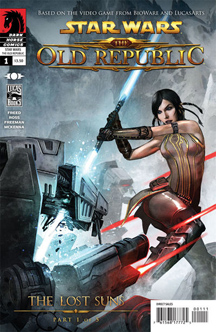“The Old Republic” franchise – which is cranking out expansions to the game to this day – used the platforms of comics and novels primarily as teasers for the game from 2010-12, with almost all of the stories being standalones. The exception came at the very end of the tie-in material rollout, when the last comic-book series, the five-issue “The Lost Suns” (2011), led into the last novel, Drew Karpyshyn’s “Annihilation” (2012).
Alexander Freed had penned the serviceable webcomic series “Blood of the Empire,” set early in the “Old Republic” era and telling the origin of Darth Thanaton. But Thanaton’s story never continued outside of the game. “The Lost Suns” is a significant step up, as Freed jumps to the time after the Treaty of Coruscant (the official end of the Republic-Sith war, as chronicled in the other webcomic arc, “Threat of Peace”) and introduces Theron Shan.
Theron is the son of Jedi Grand Master Satele Shan, but – giving the title a second meaning – she gave him up as a baby to be raised by her former master, Zho, presumably because she opted to focus on her Jedi duties. Zho raises and trains Theron as a Jedi on the Jedi Temple world of Haashmut – we get workout scenes that call to mind the Dagobah sequence in “Episode V” – and tells him to journey to the grounds of a Jedi enclave as his last trial. While they are polite about it, those Jedi reject Theron because he has no Force ability – and he never did, although Theron didn’t realize that because Zho never told him.
I appreciate the subtlety of “The Lost Suns.” The story follows the adult Theron, now a skilled Republic Strategic Information Service officer in the vein of James Bond, who is investigating the Sith Empire’s rumored crimes against humanity. Zho turns up as a crazy, amnesiac old man who had spent decades in Sith space, initially on a reconnaissance mission, but ultimately a humanitarian mission to help slaves as best he can with his Force abilities. Theron – like the reader – is never entirely sure if he should despise or forgive Zho for sending him away and not telling him the truth.
Tiff’ith, a low-level Twi’lek criminal whom Theron picks up along the way, is likewise an intriguing cipher. While she complains about being along for this impromptu ride, at least it means Theron doesn’t have time to pursue charges, and she ultimately becomes an ally. Rounding out the hodgepodge foursome is the droid M-6, whose name not coincidentally calls to mind the British spy agency MI-6.
Our heroes eventually learn that Darth Mekhis is using a superweapon to mine suns of their valuable matter, and among her armory will be another superweapon, essentially a Galaxy Gun, like in “Dark Empire II.” While clichéd, the superweapon reveal isn’t a letdown, because Freed spends enough time explaining the logistics of the operation.
With some scenes taking place on Taris (“Knights of the Old Republic”) and some on Tython (“Dawn of the Jedi”), “The Lost Suns” features welcome tie-ins to other parts of the timeline. More importantly, it builds story momentum for the first time in “The Old Republic” comics/novels saga. Some of it will pay off in “Annihilation,” although I would’ve gladly followed this group through even more stories.

As a consolation prize, though, the concepts of “The Lost Suns” would quickly be picked up in other “Star Wars” sagas. The chilling idea of the Republic giving up on seven star systems – ceding them to seven Sith lords – is similar to the premise of the novel and comic series “Knight Errant” (2010-12), set just before the time of Darth Bane, where lone Jedi Knight Kerra Holt finds herself trapped in Sith space. And the concept of a James Bond-like hero is revisited in the comic series “Agent of the Empire” (2011-13), set during the time of Palpatine’s Empire.
Between the two “Star Wars” Bond tributes, I lean toward Theron Shan over “Agent of the Empire’s” Jahan Cross. Theron is a self-made man who has overcome the crushing blows of abandonment and not having Force abilities, and – unlike Cross – he serves a relatively noble government.

